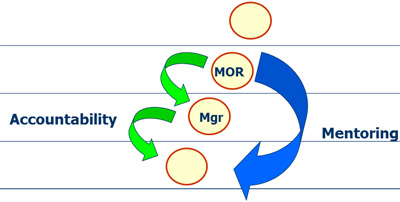From the Ask Tom mailbag –
I have to set this up, because the source of this discussion began in January of this year. On this site, under Organizational Models, I listed a specific reference to Jim Collins and his take on organizational layers.
- Level 5 – Level 5 Executive
- Level 4 – Effective Leader
- Level 3 – Competent Manager
- Level 2 – Contributing Team Member
- Level 1 – Highly Capable Individual
What makes this question special is that it was posed by Herb Koplowitz. Herb is a contributing editor to the Global Organization Design Society, a deep, international resource on organizational design, based in large part on the research of Elliott Jaques.
This is Part 1 of 5 in a series.
Question:
I didn’t read Collins’ levels as layers, but as personality fit to being a good manager. (He actually describes behaviors and then ascribes them to the manager as though ones manager has nothing to do with ones behavior.) Please explain how you see Collins’ levels as relating to Jaques’ strata. What is Stratum I about being a capable individual, what is Stratum II about being a contributing team member?
Response:
Since 2003, I have conducted more than 300 workshops for more than 3,500 CEOs, sharing the research of Elliott Jaques. By a show of hands, I always ask, who has any exposure to this research. Over the years, less than 100 have raised their hands.
“Next question,” I ask, “Who has read Good to Great, by Jim Collins?” Almost 100 percent have read, own a copy of the book and memorized that most famous bus analogy, right people, right seats.
I look at Collins, not because he is the best place to start, but because his book is a familiar touchstone in the room.
I didn’t piece some of this together until I was working with an independent school district in Detroit. Their organization, mildly different from manufacturing, held roles like superintendents, principals and teachers. There was interest to look at Requisite Organization to see how it might help in understanding the accountability and authority tied to each role.
And everyone in the room was familiar with Good to Great.
Collins provides a chart depicting his framework of Level Five Leadership. His focus in the book was on Level V, leaving us with only brief descriptions of the levels of work below. Rather than pick them apart, I looked for intersection, to see where Jaques could be instructive and helpful in understanding each level described by Collins.
Level V – Level V Leadership
Level IV – Effective Leader
Level III – Competent Manager
Level II – Contributing Team Member
Level I – Individual Contributor
Level 1 – Collins – Individual Contributor. When I think about the decisions at Stratum I (Requisite Organization), most of those decisions fall to pace and quality.
- In my role, given my work instructions, am I working fast enough to complete the task within the time span allotted?
- At that pace, is the output of my work within the quality standards set by my manager?
That is my accountability.
My authority is to adjust my work-pace and attention-to-quality to meet the task assignment. My authority is to judge whether I can meet the pace and quality set by my manager, and if not, then it is my accountability to tell my manager. It is all about me and my work, with the longest Time Span task assignments landing between one day and three months.
Tomorrow, we will look at Collins-Contributing Team Member and Jaques-Stratum II.
